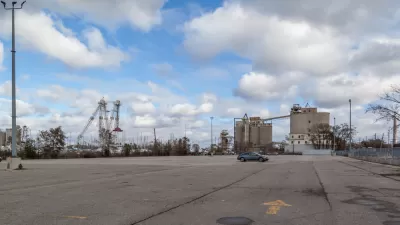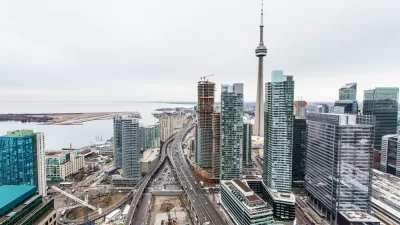Sidewalk Labs' proposals for the Toronto neighborhood of Quayside reveals a preference for ride hailing over public transit.

Paris Marx has read the response to the Request for Proposals for a high-profile "smart city" project in the Toronto neighborhood of Quayside, and what he found will not be welcome among transit advocates.
Marx points to page 133 of the proposal, finding a graph that reveals the transportation priorities of Sidewalk Labs. According to Mark, if Sidewalk Labs pursues its vision, "[t]ransit use would only increase by a single percentage point, while automobile use would be reduced to 15 percent by a larger uptake of walking and cycling (35 percent) and the use of driverless vehicles, ride hailing, and car share services (10 percent)."
There are several specific sections of the proposal that Marx reads as giving priority to ride hailing and driverless vehicles—even potentially over pedestrians and cyclists. The proposals calls for "non-hierarchical streets," for instance, would abandon the complete streets layout that most benefits alternative transportation, according to Marx. The most troubling section of the report, to Marx, is the call for shared ride zones, "where Quayside residents would get subsidized shared-ride trips instead of taking transit."
The article does highlight some portions of the proposal that provide more positives for alternative transportation modes and technological advancements that could potentially benefit every mode but eh automobile. The proposal would extend transit lines to better connect Quayside to the rest of the city's transit infrastructure. Marx is also careful to note the small scale of the project—the neighborhood only covers 12 acres, but Sidewalk Labs does have larger plans to parlay its work in Quayside to the entire East Waterfront neighborhood.
FULL STORY: Sidewalk Toronto Puts Ride Hailing Before Public Transit

Planetizen Federal Action Tracker
A weekly monitor of how Trump’s orders and actions are impacting planners and planning in America.

San Francisco's School District Spent $105M To Build Affordable Housing for Teachers — And That's Just the Beginning
SFUSD joins a growing list of school districts using their land holdings to address housing affordability challenges faced by their own employees.

The Tiny, Adorable $7,000 Car Turning Japan Onto EVs
The single seat Mibot charges from a regular plug as quickly as an iPad, and is about half the price of an average EV.

Seattle's Plan for Adopting Driverless Cars
Equity, safety, accessibility and affordability are front of mind as the city prepares for robotaxis and other autonomous vehicles.

As Trump Phases Out FEMA, Is It Time to Flee the Floodplains?
With less federal funding available for disaster relief efforts, the need to relocate at-risk communities is more urgent than ever.

With Protected Lanes, 460% More People Commute by Bike
For those needing more ammo, more data proving what we already knew is here.
Urban Design for Planners 1: Software Tools
This six-course series explores essential urban design concepts using open source software and equips planners with the tools they need to participate fully in the urban design process.
Planning for Universal Design
Learn the tools for implementing Universal Design in planning regulations.
Smith Gee Studio
City of Charlotte
City of Camden Redevelopment Agency
City of Astoria
Transportation Research & Education Center (TREC) at Portland State University
US High Speed Rail Association
City of Camden Redevelopment Agency
Municipality of Princeton (NJ)




























